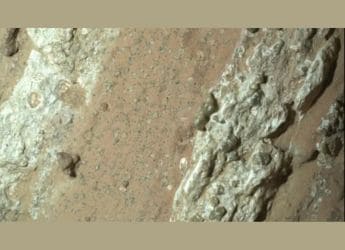- Home
- Science
- Science News
- Plasma Based Method Utilises Carbon Dioxide on Mars to Make Oxygen
Plasma-Based Method Utilises Carbon Dioxide on Mars to Make Oxygen
Plasma is the fourth natural state of matter and contains free-charged particles like electrons and ions.

Photo Credit: NASA
Producing oxygen on Mars isn't that easy and comes with several challenges
If humans are ever able to safely make their descent on Mars, there is now a possibility for them to get plenty of oxygen to breathe on the Red Planet. This can be possible due to a new plasma-based method developed by scientists, through which the resources available in the Martian environment can be utilised to make oxygen. The method would not only allow astronauts to breathe on the planet during future Mars missions, but could also help make fuel, building materials, and fertilisers there.
Mars' atmosphere mainly consists of carbon dioxide gas that can be split to make oxygen. The environment on the Red Planet, due to its pressure, is also conducive to plasma ignition. Hence, conditions on Mars are favourable for making in-situ oxygen through resource utilisation by plasma.
Producing oxygen on Mars isn't that easy and comes with several challenges. According to Vasco Guerra of the University of Lisbon, the decomposition of carbon dioxide molecules to extract oxygen is a tricky process as the molecules are difficult to break. Even when the carbon dioxide is split, the produced oxygen will have a mixture of gases like carbon monoxide and dioxide that would need to be removed.
“We're looking at these two steps in a holistic way to solve both challenges at the same time. This is where plasmas can help,” said Guerra, who is also the author of the study published in the Journal of Applied Physics.
Plasma is the fourth natural state of matter and contains free-charged particles like electrons and ions. These electrons are quite light and can be easily accelerated up to high energies using electric fields. When the electrons collide with a carbon dioxide molecule, it can decompose it or transfer the energy to make it vibrate, explained Guerra. “This energy can be channelled, to a large extent, into carbon dioxide decomposition. Moreover, the heat generated in the plasma is also beneficial for the separation of oxygen,” he added.
Get your daily dose of tech news, reviews, and insights, in under 80 characters on Gadgets 360 Turbo. Connect with fellow tech lovers on our Forum. Follow us on X, Facebook, WhatsApp, Threads and Google News for instant updates. Catch all the action on our YouTube channel.
Related Stories
- Samsung Galaxy Unpacked 2025
- ChatGPT
- Redmi Note 14 Pro+
- iPhone 16
- Apple Vision Pro
- Oneplus 12
- OnePlus Nord CE 3 Lite 5G
- iPhone 13
- Xiaomi 14 Pro
- Oppo Find N3
- Tecno Spark Go (2023)
- Realme V30
- Best Phones Under 25000
- Samsung Galaxy S24 Series
- Cryptocurrency
- iQoo 12
- Samsung Galaxy S24 Ultra
- Giottus
- Samsung Galaxy Z Flip 5
- Apple 'Scary Fast'
- Housefull 5
- GoPro Hero 12 Black Review
- Invincible Season 2
- JioGlass
- HD Ready TV
- Laptop Under 50000
- Smartwatch Under 10000
- Latest Mobile Phones
- Compare Phones
- Honor Win RT
- Honor Win
- Xiaomi 17 Ultra Leica Edition
- Xiaomi 17 Ultra
- Huawei Nova 15
- Huawei Nova 15 Pro
- Huawei Nova 15 Ultra
- OnePlus 15R
- Asus ProArt P16
- MacBook Pro 14-inch (M5, 2025)
- OPPO Pad Air 5
- Huawei MatePad 11.5 (2026)
- Xiaomi Watch 5
- Huawei Watch 10th Anniversary Edition
- Acerpure Nitro Z Series 100-inch QLED TV
- Samsung 43 Inch LED Ultra HD (4K) Smart TV (UA43UE81AFULXL)
- Asus ROG Ally
- Nintendo Switch Lite
- Haier 1.6 Ton 5 Star Inverter Split AC (HSU19G-MZAID5BN-INV)
- Haier 1.6 Ton 5 Star Inverter Split AC (HSU19G-MZAIM5BN-INV)

















